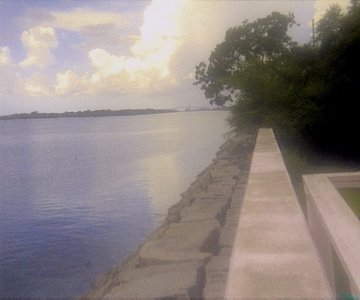 Just a personal note here tonight, after a day of watching Hurricane Rita coverage on various cable channels.
When I was growing up in Port Arthur, Texas, we had an old saying that went something like this. If you wake up in the morning and your bed is surrounded by water, roll over and dip your finger in the water. If it's fresh water, go back to sleep. It's no big deal. The pumps will take care of it sooner or later.
Just a personal note here tonight, after a day of watching Hurricane Rita coverage on various cable channels.
When I was growing up in Port Arthur, Texas, we had an old saying that went something like this. If you wake up in the morning and your bed is surrounded by water, roll over and dip your finger in the water. If it's fresh water, go back to sleep. It's no big deal. The pumps will take care of it sooner or later.
However, if you roll over and taste salt in the water, get out of town because the seawall (pictured) is down and that means the Gulf of Mexico is coming back to claim everything.
Actually, it is never a very good idea to taste the water in that part of the world, because of all the oil and chemical processing plants. Some of this colorful atmosphere ended up in the music of local artists, people like the Winter brothers and that renegade named Janis Joplin.
Anyway, the sea wall held once again and the pumps will eventually get rid of the rainwater. But today also left me thinking about another reality linked to journalism and its, well, struggles to pin a news value on life and destruction.
I have to admit that I did rather enjoy watching Geraldo Rivera grandstand in the wasted downtown city streets of my old hometown. I kept waiting for him to wrap himself around the Janis Joplin statue during a big gust of wind.
It was also fun listening to the visiting newscasters find new and unique ways of saying things like Sabine Pass (it's suh-bean, not SAY-bine). It was also clear that the MSM, for obvious reasons, was set up for Houston and Galveston, not for all of those strange out-of-the-way places in Southeast Texas. I loved the moment on CNN when someone said, "Jasper? I guess we're going to have to find out where Jasper is."
Maybe so. People live there, after all. But for most of today, the MSM reports were still dominated by visuals and information from New Orleans and from Houston-Galveston. I know why this is and it is, of course, all about numbers. This is understandable.
It made me think about that old myth about The Associated Press having a chart that shows the value of a human life, in news terms. If you are a journalist, you have heard about this.
In terms of people being killed in catastrophic events, one American dying is equal to 10 Brits or 50 people in France, which is equal to 100 people in Mexico and maybe 1,000 people in Afghanistan (unless those Afghan deaths would somehow hurt President Bush politically and make it harder to nominate a cultural conservative to that other open chair at the U.S. Supreme Court).
It's a nasty, cynical concept, but precisely the sort of things journalists laugh about during long days in tired newsrooms. And that's what I have been thinking about today. How many people in worn-out Texas and Louisiana refinery towns does it take to equal how many hip, NPR-feature-worthy folks in a colorful city such as New Orleans? I mean, try to imagine someone writing something crazy like this about flooded small towns along the Texas-Louisiana border:
New Orleans, our old flame, how bitterly we hate it that this has befallen you. Fate is crueler than we feared, to strip away the illusions that made us love you even better in your rich, ripe age than in the headlong passion of youth -- which we secretly rekindled, if only in memory, each time we sank again into your warm embrace.
And, yes, of course, we'll come to you again. Only perhaps not just yet, not in the merciless glare of the emergency ward, with the tubes encircling you like water snakes and the inescapable whiff of the bedpan.
Believe it or not, that is from The Dallas Morning News and it is not satire.
I understand. Honest, I do. I'm a veteran in the news business. But still, thinking about all of this created an interesting emotional undercurrent during a long day. Not all towns and not all people are created equal, in the headlines.
The seawall held. That's the news.
